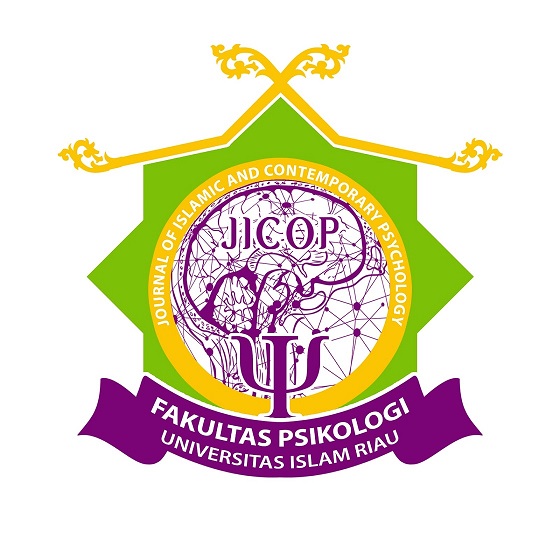Hubungan Religiositas dengan Kebahagiaan Masyarakat Sabak Auh Kabupaten Siak
DOI:
https://doi.org/10.25299/jicop.v2i1.9259Keywords:
Religiosity, Happiness, SocietyAbstract
This study aimed to determine the relationship of religiosity with the happiness of the people of Sabak Auh District, Siak Regency. Happiness is something that becomes hope in one's life. One of the factors that contribute to happiness is religiosity. This research uses a descriptive research method using a correlation technique, with a random sampling technique. The research samples were 81 people from Sabak Auh District, Siak Regency. The results of the correlation test between the religiosity variable and the happiness variable were significantly 0.000 (p <0.05) which shows positive relationship between these two variables with a correlation value of 0.701. The higher the religiosity, the higher the happiness, conversely the lower the religiosity, the lower the happiness, which means one increases as the other decreases.
Downloads
References
Al-Bugho, M. (2014). Pokok-Pokok Ajaran Islam. Jakarta: Alams Books Publishing.
Ancok, D., dan Suroso, N. (2011). Psikologi Islami, Solusi Islam Atas Problem-Problem Psikologi. Yogyakarta: Pustaka Pelajar.
Boeree, C.G. (2010). Personality Theories. Yogyakarta: Prisma Sophie.
Carr, A. (2001). Abnormal Psychology: Psychology Focus. New York: McGraw Hill Inc Press.
Elfida. (2008). Hubungan antara religiositas dan kebahagiaan masyarakat kecamatan tampan. (Skripsi). UIN Suska Riau: Tidak diterbitkan.
Fridayanti (2015). Religiositas, spritualitas dalam kajian psikologi dan urgensi perumusan religiositas Islam. Psympathic, Jurnal Ilmiah Psikologi, 2(2), 199 – 208. DOI: https://doi.org/10.15575/psy.v2i2.460
Ghufron, N., & Risnawita. (2014). Teori-Teori Psikologi. Jogjakarta: Ar-Ruzz.
Jaenudin, U. (2012). Psikologi Kepribadian. Bandung: Pustaka Setia.
Lestari, S. (2012). Psikologi Keluarga. Jakarta: Kencana.
Nurhidayah, S., & Agustini, R. (2012). Kebahagiaan lansia ditinjau dari dukungan sosial dan spiritualitas. Jurnal Soul, Vol. 5, No. 2, 15-32.
Papalia, Diane.,Old, Sally Wendkos., Feldman Ruth Duskin. (2008). Human Development. Jakarta: Kencana.
Rajab, K. (2011). Psikologi Ibadah. Jakarta: Amzah.
Ramayulis. (2013). Psikologi Agama. Jakarta: Kalam Mulia.
Seligman, M.E.P. (2005). Authentic Happines: Menciptakan Kebahagiaan Dengan Psikologi Positif. Terjemahan Eva Yulia Nukman. Bandung: Mizan.
Sillick, W.J., Stevens, B.A., dan Cathcart, S. (2016). Religiosity and happiness: A comparison of the happiness levels between the religious and the nonreligious. The Journal of Happiness & Well-Being, 4(1), 115-127.
Sugiyono. (2016). Statistika untuk penelitian. Bandung: Alfabeta.
Wallace, J.M. (2005). The contributions of spirituality and religious practice to children’s happiness. (Tesis) University British Columbia.
Downloads
Published
How to Cite
Issue
Section
License
This work is licensed under a Creative Commons Attribution - ShareAlike 4.0 International License (CC BY-SA)
This is an open-access article distributed under the terms of the Creative Commons Attribution-ShareAlike 4.0 International License which permits unrestricted use, distribution, and reproduction in any medium. Copyrights of all materials published in Journal of Islamic and Contemporary Psychology (JICOP) are freely available without charge to users or / institution. Users are allowed to read, download, copy, distribute, search, or link to full-text articles in this journal without asking by giving appropriate credit, provide a link to the license, and indicate if changes were made. All of the remix, transform, or build upon the material must distribute the contributions under the same license as the original.








